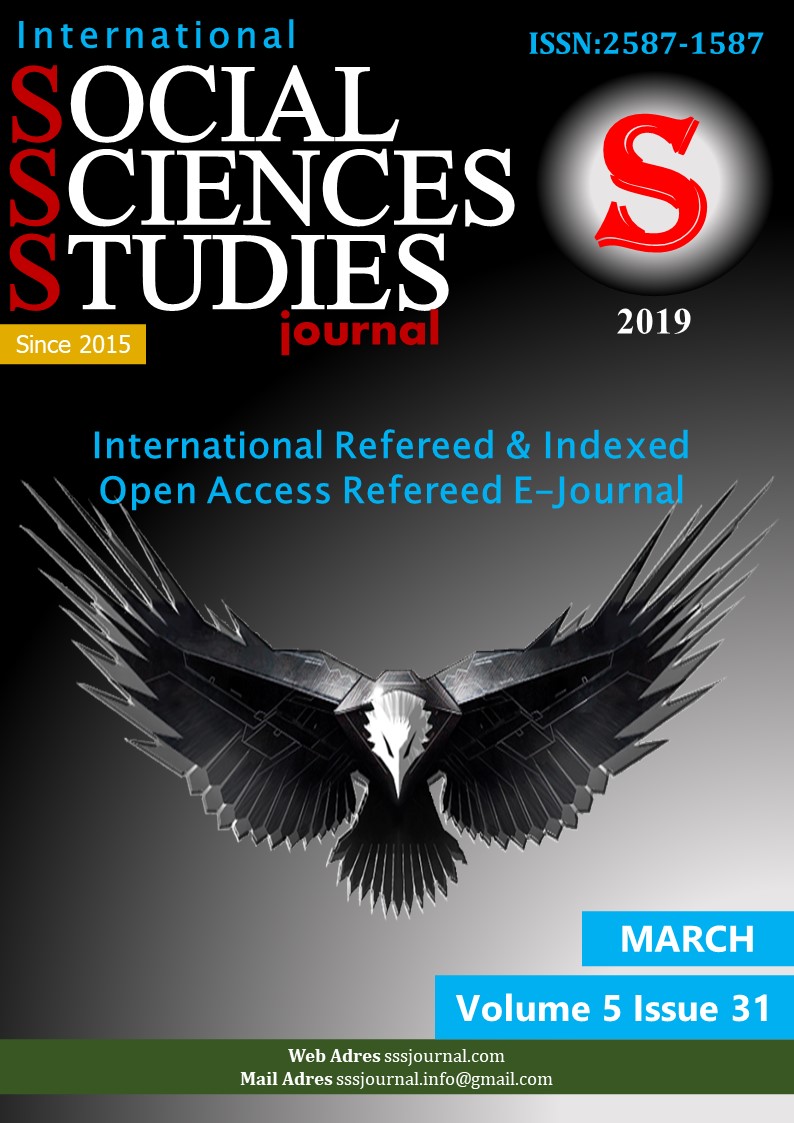A Scientific Research On An Ottoman Superstition: Do The Celadons Change Their Color When Touched By A Poison ?
Author :
Abstract
Bu çalışmada popüler bir bilgi olan seladonların zehiri belli etmesine dair olan inanışın bilimsel bir gerçekliğinin olup olmadığını araştırmak hedeflenmiştir. Bu amaç doğrultusunda Dünya’daki benzer inanışlar araştırılmıştır. Osmanlı İmparatorluğu’nun Dünyadaki en önemli üç seladon koleksiyonlarından birine sahip olması nedeni ile Osmanlı Döneminde kullanılan bazı zehirler, seladon bünye üzerinde denenmiştir. Ulaşılabilen ilgili yayınlardan, çalışmanın konusu olan seladonların Uzakdoğu da, en değerli taş olan yeşim taşına benzediği ve yeşim taşının zehiri belli ettiğine dair, inanışın olduğu anlaşılmıştır. Bilerek ya da bilmeyerek zehirlenmenin sınıf ayrımı olmaksızın herkesin başına gelebileceği için dikkat ile ilgi uyandırdığı ve bu ilginin, ürünlerini daha değerli kılmak için 16. yy’da Uzakdoğu’dan ürün getiren tüccarlar tarafından değerlendirildiği görülmüştür. Osmanlı Döneminde makyaj malzemesi gibi günlük yaşamda kullanılan, aynı zamanda zehirleme silahı olan kimyasal bileşikler, seladon bünye ile denendiğinde, herhangi bir renk değişimi olmamıştır. Ayrıca bu deneylerle seladonların, ataların düşündüğü gibi zehirlerden korumadıkları anlaşılmıştır.
Keywords
Abstract
This study aims to investigate whether there is a scientific reality within the popular belief of celadon demonstrating the poison. Thus, its use in the Ottoman Empire which contributed to the establishment of significant collection of celadon in the world was taken as the basis of this study. For this purpose, some similar superstitions and poisons in the world were studied. Accessible chemicals especially used in Ottoman Empire were selected and tested for the verification of toxicity with celadons. It has been understood that the celadon, main subject of this study, is resembled to jade stone which was the most precious stone in early times of Far East and believed to protect from poison. Poisoning is remarkable as it can happen to anyone no matter what class they belong to and this concern was used to earn more money by merchants who took roads between East and West. Chemical compounds which were used in daily life such as make-up materials were also used as weapons for poisoning in the Ottoman period. When these chemicals were tested with celadon, it has been observed that no color change has occurred. It also has been proved through these experiments that celadons don't protect from poisoning as antecedents thought.
Keywords
- 1840- 1908, Journal of Women’s History: 28. 3,p. 114- 137, 2016.
- the Ottoman period), Osmanlılarda Sağlık:1,p. 9- 17, 2006.
- 146, 1996.
- Carswell, John. Blue And White Chinese Porcelain Around The World, Chicago: Art Media Resources, 2000.
- Dolma with Datura Stramonium, Turk J Emerg Med 15. 1, p. 51-55, 2015.
- Sene-i Devriyesi İçün Nüsha-i Fevkalade’si (1927), Osmanlı Bilimi Araştırmaları: 15. 1, p. 1-39, 2013.
- Thomas Barker,Journal of the Economic and Social History of the Orient: 19. 2, p. 182-214, 1976.
- Forrest, James T. Folk Medicine, Midwest Folklore: 1.2, p.121-123, 1951.
- Glazed Ceramic Cookware, CMAJ, 188, p. 17–18, 2016.
- Gerlach, Stephan. Türkiye Günlüğü (1573- 1576), I, İstanbul: Kitap Yayınevi 2007.
- Gleeson, Janet. The Arcanum, New York: Warner Books, 1998.
- Madencilik, Kimya Terimleriyle İlişkileri, Turkish Studies: 5. 2, p.1033- 1087, 2010.
- Dergisi, 7, p. 123- 145, 2011.
- Period,Islamic Law And Society: 1. 2, p. 206- 216, 1994.
- Children,Acta Pediatrica Scandinavica, 54, p. 331- 335, 1965.
- Araştırmaları: 15.2,p. 21-38, 2014.
- Sotheby’s Publications, Topkapı Saray Museum 1986.
- Yayınları 1987.
- Lane, Arthur. Early Islamic Pottery, New York: D. Van Nostrand Company 1948.
- and Courtauld Institutes,32,p. 228- 279, 1969.
- 121, 1988.
- Gotch Paul. Survey of Excavations in Iran During 1966-67, Iran, 6, p. 157-171, 1968.
- Kullanımı, Acta Turcica, 7,p. 34- 50, 2012.
- Quarterly: 23. 1, p. 19-22, 1960.
- 27- 54, 1986.
- Complete Catalogue, Topkapı Saray Museum, London: Sotheby’s Publications 1,p. 55- 63, 1986.
- Radenkova, Julia Saeva. Historical Development of Toxicology,Acta Medica Bulgarica: 35. 1, p. 47- 52, 2008.
- Raloff, Janet. Stealing a Horn of Plenty, Science News:116.20, p. 346-348, 1979.
- Roberts, Jeremy. Chinese Mythology A to Z, USA: Chelsea House An imprint of Infobase Publishing 2010.
- Sadberk Hanım Müzesi Kataloğu,İstanbul: Vehbi Koç Vakfı Yayını 1995.
- Sahih-i Buhari Muhtasarı Tecrid-i Sarih, çev. Abdullah Feyzi Kocaer, Konya: Hüner Yayınları, 2004.
- Sakaoğlu, Necdet. Bu Mülkün Sultanları, İstanbul: Oğlak Bilimsel Kitaplar 2010.
- Savage, George. Porcelain Through the Ages, London: Cassel & Company 1961.
- Araştırmaları,6,p. 95- 149, 2000.
- Webster, Richard. The Encyclopedia of Superstitions, Minnesota: Llewellyn Publications 2008.
- Of Distance Learning, 2011.
- Yıllığı, 1, p. 77- 99, 2012.
- Bilimi Araştırmaları:11. 1-2, p. 273- 283, 2009- 2010.
- 100 Objects British Museum, Jade Dragon Cup; (Accessed in July 20, 2018)
- Forensic Chemistry Course.vital Articles on science; (Accessed in August 9, 2018)
- Aksülümen, A Poison of Ottoman Times;(Accessed in February 6, 2018)
- American Museum of Natural History; (Accessed in July 26, 2018)
- Müdürlüğü;(Accessed in February 6, 2018)
- British Museum; (Accessed in August 12, 2014)
- Hogarth, Brian: Ancient China: From the Neolithic Period to the Han Dynasty,Asian Art Museum, XX (1999),
- no page numbers. Vital Articles on Science(Accessed in August 9, 2018)
- Veggie Cage, “Tomato History”,(Accessed in February 6, 2018)
- Eyman, Scott: “Chinese Porcelain and Pottery on Display at Norton” Palm Beach Post, 03 Sep 2010: T.27.
- Righter, Rosemary: “Chinese connections; Introduction”, The Times,London: (UK) 30 Aug 1996.
- 1992: 19.





